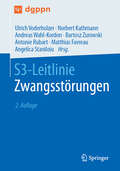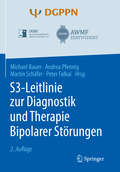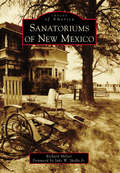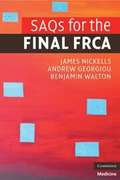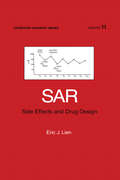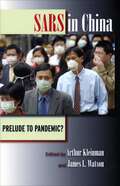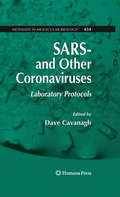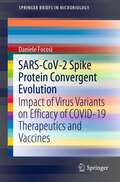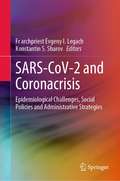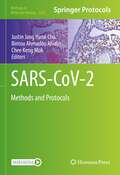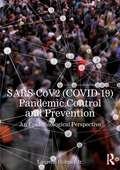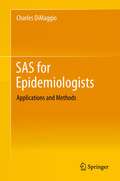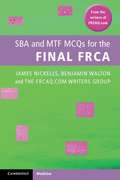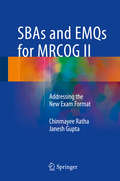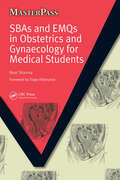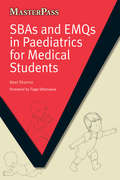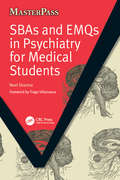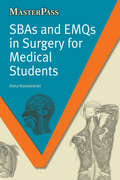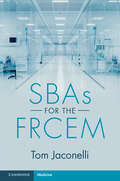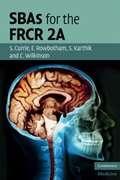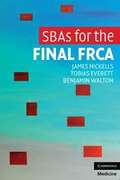- Table View
- List View
S3-Leitlinie Zwangsstörungen
by Ulrich VoderholzerDie erste Revision der S3-Leitlinie zur Behandlung von Zwangsstörungen bei Erwachsenen wurde wieder unter Beratung und Moderation durch die Arbeitsgemeinschaft der wissenschaftlichen medizinischen Fachgesellschaft (AWMF) von einem großen Gremium an wissenschaftlichen Experten und Vertretern von Fachverbänden erstellt. Die Empfehlungen der revidierten Fassung basieren auf einer Sichtung der Evidenz der verfügbaren randomisierten klinischen Studien zu Zwangsstörungen sowie der Meta-Analysen dazu, einer Synthese der Empfehlungen anderer Leitlinien sowie einem Expertenkonsens bei den Fragen, zu denen es keine Evidenz aus Studien gibt. Aufgrund der großen Datenbasis sowie der breiten klinischen Erfahrungen von Experten auf dem Gebiet können in dieser Leitlinie konkrete und fundierte Empfehlungen für die Behandlung der Zwangsstörungen gegeben werden. Änderungen der ersten Revision der Leitlinie im Vergleich zur Ursprungsversion aus dem Jahre 2013 betreffen insbesondere die weitere Stärkung des Stellenwertes der kognitiven Verhaltenstherapie mit Exposition, die nach neueren Meta-Analysen das wirksamste Therapieverfahren und daher Therapie der ersten Wahl ist. Neu ist die Empfehlung für hochfrequente Expositionsübungen, z.B. im Blockformat, die, wo die Voraussetzungen vorliegen, genutzt werden sollten. Darüber hinaus wurden Empfehlungen zur Pharmakotherapie bei Therapieresistenz wesentlich überarbeitet, weil es in diesem Bereich in den vergangenen 10 Jahren viele neue Studien gab. Weitere neue Empfehlungen betreffen spezielle Behandlungsaspekte, den Umgang mit Komorbidität und die Versorgung, die in der ursprünglichen Leitlinie nicht enthalten waren.
S3-Leitlinie zur Diagnostik und Therapie Bipolarer Störungen
by Michael Bauer Peter Falkai Andrea Pfennig Martin SchäferLeitlinien dienen dazu, Versorgungsfragen zu formulieren, das umfangreiche Wissen dazu zusammenzutragen und kritisch zu bewerten, gegensätzliche Standpunkte zu klären und das derzeitige Vorgehen der Wahl zu definieren. Sie sollen Patienten, Angehörige und Therapeuten bei der Entscheidung über angemessene Maßnahmen der Krankenversorgung unter spezifischen medizinischen Umständen unterstützen.Dieses Buch enthält die Langversion der S3-Leitlinie zur Diagnostik und Therapie Bipolarer Störungen mit Stand Februar 2019. Diese stellt eine aktuelle, überarbeitete Fassung der ersten Version der Leitlinie dar, welche 2012 veröffentlicht wurde, und enthält neben überarbeiteten auch neu generierte Abschnitte, Statements und Empfehlungen.
SANATORIUMS of New Mexico
by Richard Melzer Jake W. Spidle Jr.Tuberculosis, also known as consumption, the White Plague, or simply TB, was the number-one killer in the United States in the late 19th and early 20th centuries. Many physicians of the era advised their patients to chase the cure for tuberculosis in the Southwest, where the region's clean, dry, fresh air, high altitude, and sunshine offered relief for most and recovery for some. New Mexico, called the "well country," was particularly eager to promote itself as a mecca for lungers with the coming of the railroad to the territory in 1880 and the creation of many new hospitals, known as sanitariums or sanatoriums ("sans"), which specialized in the treatment of TB. This is a brief history of New Mexico's sans, their patients, and the doctors, nurses, and staff who served them during the golden age of the TB industry, from the turn of the 20th century to the eve of World War II.
SAQs for the Final FRCA
by James Nickells Ben Walton Andy GeorgiouSAQs for the Final FRCA is an invaluable guide to the Short Answer Question paper for the Final FRCA examination, providing 9 papers of 12 questions per paper. Each question is accompanied by a full model answer structured using a star system to indicate the essential, desirable and supplementary information. Most answers also carry references and additional notes giving insight into why a question was written or what the examiner was really after. A highly informative FAQ section gives advice on all aspects of exam preparation. The book is laid out to enable the candidate to practise sitting whole papers of 12 questions or to attempt individual questions. Written by a group of authors who have either just successfully taken the Final FRCA or are regularly involved with training anaesthetists via the Frenchay Final FRCA Crammer Course, SAQs for the Final FRCA is an invaluable tool for your exam preparation!
SAR: Side Effects and Drug Design
by Eric J. LienThis book focuses on the quantitative structure-activity relationship of the disposition and activities of various pharmacological groups. It presents a systematic approach for linking different side effect of drugs to their molecular structure and physiochemical properties.
SARS in China: Prelude to Pandemic?
by Arthur Kleinman James L. WatsonThe SARS epidemic of 2003 was one of the most serious public health crises of our times. The event, which lasted only a few months, is best seen as a warning shot, a wake-up call for public health professionals, security officials, economic planners, and policy makers everywhere. SARS (Severe Acute Respiratory Syndrome) is one of the "new" epidemics. SARS in China addresses the structure and impact of the epidemic and its short and medium range implications for an interconnected, globalized world. After initially stalling and prevaricating, the Chinese government managed to control SARS before it became a global catastrophe, an accomplishment that required political will and national mobilization. Recent warnings from the World Health Organization (WHO) and the Centers for Disease Control and Prevention (CDC) regarding avian flu make it clear that SARS may have been a prelude to bigger things. The contributors to this volume include a journalist, WHO's representative in Beijing, and health care professionals, several of whom found themselves on the frontlines of the battle to understand and control SARS. Their vivid, first-hand accounts encouraged other contributors to go beyond the boundaries of their respective disciplines and write for a wide audience. The authors of this volume focus on specific aspects of the SARS outbreak—epidemiological, political, economic, social, cultural, and moral. They analyze SARS as a form of social suffering and raise questions about the relevance of national sovereignty in the face of such global threats. Taken together, these essays demonstrate that SARS had the potential of becoming a major turning point in human history. This book thus poses a question of the greatest possible significance: Can we learn from SARS before the next pandemic? Contributors: Erik Eckholm Joan Kaufman Arthur Kleinman Dominic Lee Sing Lee Megan Murray Thomas G. Rawski Tony Saich Alan Schnur James L. Watson Hong Zhang Yun Kwok Wing
SARS in Context
by Arthur Sweetman Jacalyn DuffinFormer Ontario Chief Coroner James Young and infectious disease expert Dick Zoutman recount their efforts to contain the mysterious new disease. In answer to questions about "lessons from the past," several distinguished historians of epidemics examine how their knowledge of responses to older plagues influenced their perception of SARS. They also reflect on how the advent of SARS alters their views of the past. Finally, policy experts comment on possible changes to health care that the SARS experience suggests should be made.
SARS in Context: Memory, History, and Policy (McGill-Queen's/Associated Medical Services Studies in the History of Medicine, Health, and Society #77)
by Arthur Sweetman Jacalyn DuffinFormer Ontario Chief Coroner James Young and infectious disease expert Dick Zoutman recount their efforts to contain the mysterious new disease. In answer to questions about "lessons from the past," several distinguished historians of epidemics examine how their knowledge of responses to older plagues influenced their perception of SARS. They also reflect on how the advent of SARS alters their views of the past. Finally, policy experts comment on possible changes to health care that the SARS experience suggests should be made.
SARS- and Other Coronaviruses
by Dave CavanaghIn 2003, the word "coronavirus" spread across the globe, somewhat further than the virus that sparked the panic. In this book, expert researchers examine these devastating viruses through 23 state-of-the-art, widely applicable protocols with minute detail. Comprehensive and cutting-edge, the book serves as an ideal guide for all virologists and especially for those working with coronaviruses. Written by international experts, this book is relevant to a wide array of professions.
SARS-CoV-2 Spike Protein Convergent Evolution: Impact of Virus Variants on Efficacy of COVID-19 Therapeutics and Vaccines (SpringerBriefs in Microbiology)
by Daniele FocosiThis book reviews the current knowledge of the globally circulating SARS-CoV-2 variants, highlights their distinct genetic characteristics and associated conformational changes in the viral spike protein, and profoundly discusses the mechanisms of convergent evolution that led to the rise of these mutated strains at different geographic regions during the Covid-19 pandemic. Furthermore, the book explores how these variants do and may impact the efficacy of established neutralizing antibody-based (nAb) vaccines and therapeutics by analysing latest in vivo and in vitro clinical data. Finally, the author discusses ways on how nAb Covid-19 treatment derived immune escape of SARS-CoV-2 could be minimized in the future.
SARS-CoV-2 and Coronacrisis: Epidemiological Challenges, Social Policies and Administrative Strategies
by Fr archpriest Evgeny I. Legach Konstantin S. SharovThis book is useful for administrators of different levels involved in counteracting COVID-19, surveillance professionals, clinicians, researchers specializing in epidemiology, microbiology, and infectious diseases, and politicians / legislators engaged in public health sector.We use an innovative approach of combining both epidemiological and sociological analyses, as the very problem is mainly an issue of correct governance. A team of authors from Europe, Russia and China summarizes their experience and knowledge useful for containing SARS-CoV-2 and overcoming social and managerial consequences of the pandemic. The editors are sure that sharing our different experience would help to elaborate necessary strategies, protocols, and principles that may be effectively applied in the future to avoid dramatic consequences of not only COVID-19 but also any possible epidemiological hazards for people and medicine.
SARS-CoV-2: Methods and Protocols (Methods in Molecular Biology #2452)
by Justin Jang Hann Chu Bintou Ahmadou Ahidjo Chee Keng MokThis detailed volume provides the increasing number of SARS-CoV-2 researchers with a useful handbook covering multidisciplinary approaches on various aspects of SARS-CoV-2 research, brought together by leading laboratories across the globe. Topics covered include techniques in clinical and diagnostic virology, basic protocols in cell and virus culture, as well as bioinformatics and proteomics approaches in cellular response studies. This comprehensive collection also covers methods in immunology, animal models, antivirals and vaccine development strategies, as well as biorisk and mitigation measurements for SARS-CoV-2 research. Written for the highly successful Methods in Molecular Biology series, chapters include the kind of detailed implementation advice that is vital for success in the lab. Practical and timely, SARS-CoV-2: Methods and Protocols serves as an ideal guide for scientists investigating this prevalent and perilous RNA virus and the novel coronavirus disease that results from it.
SARS-CoV2 (COVID-19) Pandemic Control and Prevention: An Epidemiological Perspective
by Laurens Holmes, Jr.This is the first comprehensive text to provide not only a detailed explanation of how the SARS-CoV2 (COVID-19) virus is spread within human populations, but also an epidemiological analysis and interpretation of viral pandemics to enable better measures for prevention and control. Providing an introduction to the physiology of both the human immune system and the SARS-CoV2 virus, specifically the virus’s replicative potential and our own vulnerability, the book offers an in-depth understanding of how the pandemic evolved. It also highlights the aberrant epigenomic mechanistic process in pathogenic microbe’s replication and survival, implying gene and environment interaction that affected different populations. Citing a range of environmental conditions, from structural and systemic racism to malnutrition and low-socioeconomic status, the book examines how these factors exacerbated existing health disparities, resulting in a disproportionate burden of morbidity and mortality on certain social groups. Also providing invaluable guidance on how future iterations of this pandemic may be better prevented and controlled, this will be a defining book for students, researchers and professionals within Public Health and Clinical Medicine to better understand the SARS-CoV2 (COVID-19) virus, and how to protect the most vulnerable social groups.
SAS for Epidemiologists
by Charles DimaggioThis comprehensive text covers the use of SAS for epidemiology and public health research. Developed with students in mind and from their feedback, the text addresses this material in a straightforward manner with a multitude of examples. It is directly applicable to students and researchers in the fields of public health, biostatistics and epidemiology. Through a "hands on" approach to the use of SAS for a broad number of epidemiologic analyses, readers learn techniques for data entry and cleaning, categorical analysis, ANOVA, and linear regression and much more. Exercises utilizing real-world data sets are featured throughout the book. SAS screen shots demonstrate the steps for successful programming. SAS (Statistical Analysis System) is an integrated system of software products provided by the SAS institute, which is headquartered in California. It provides programmers and statisticians the ability to engage in many sophisticated statistical analyses and data retrieval and mining exercises. SAS is widely used in the fields of epidemiology and public health research, predominately due to its ability to reliably analyze very large administrative data sets, as well as more commonly encountered clinical trial and observational research data.
SAVING WOMEN'S LIVES: Strategies for Improving Breast Cancer Detection and Diagnosis
by Institute of Medicine National Research Council of the National AcademiesThe National Academies Press (NAP)--publisher for the National Academies--publishes more than 200 books a year offering the most authoritative views, definitive information, and groundbreaking recommendations on a wide range of topics in science, engineering, and health. Our books are unique in that they are authored by the nation's leading experts in every scientific field.
SBA Questions for the Part 2 MRCOG
by Amanda JonesSBA Questions for the Part 2 MRCOG is a valuable preparation resource aimed at those specialising in Obstetrics and Gynaecology who are planning to take the Part 2 MRCOG examination. It contains two hundred practice single best answer questions written by MRCOG question writers, with accompanying explanations and references. It also contains an introduction to the new format of the examination and the rationale for the changes. The first section consists of two hundred single best answers allowing the reader to test their knowledge. The second section lists the correct response accompanied by an explanation and suggestions for further reading. SBA Questions for the Part 2 MRCOG is the only official preparation book produced by the RCOG and is therefore essential reading for candidates sitting this examination in its new format.
SBA and MTF MCQs for the Final FRCA
by James Nickells Benjamin Walton FRCAQ.COM Writers Group, Bristol National Health Service TrustPreparing for the Final FRCA? Wondering what to expect of the SBA questions? Help is at hand. This practical book contains 60 single best answer and 120 multiple true/false questions to help you revise for the Final FRCA MCQ exam. Each question is accompanied by detailed explanations, giving additional information on each topic to enhance revision. SBA and MTF MCQs for the Final FRCA may be used both for examination practice and as a source of knowledge on many of the key topics in the syllabus. A helpful introductory section gives practical advice on how to approach revision and sitting the exam. From the writing team behind the FRCAQ.com website (www.frcaq.com), an outstanding exam preparation source for both the Primary and Final FRCA, this book provides challenging questions and well researched explanations to help you through the Final FRCA MCQ paper. An invaluable tool for your MCQ exam preparation.
SBAs and EMQs for MRCOG II
by Chinmayee Ratha Janesh GuptaThis book is a comprehensive collection of questions in the "single best answer (SBA)" format for the MRCOG2 theory exam. This new format has been introduced in the exam paper from March 2015 and most candidates are still getting used to the change. This book will provide them ample opportunity to familiarize themselves with the concept and then practice answering the questions based on almost all subjects included in the MRCOG 2 theory syllabus. Preparing for the MRCOG2 exam is a daunting task for all Obstetrics and Gynecology doctors. The college constantly reforms the exam structure in an effort to optimize the evaluation process. The endeavor of the authors is to equip the candidates with a vision of the holistic nature of the exam so that they master the art of answering SBA questions.
SBAs and EMQs in Obstetrics and Gynaecology for Medical Students (Masterpass Ser.)
by Neel Sharma'Regardless of your level of obstetrics and gynaecology knowledge and experience, this book will most definitely have something to offer you.'- Tiago Villanueva in his Foreword. Undergraduate medical students often struggle with at least some of the specialty elements of their studies. Some face a further challenge with the advent of the Medical Schools Council Assessment Alliance (MSC-AA, formerly known as UMAP), with a move away from testing specific clinical facts to an assessment focused on preparing to be a foundation doctor and the knowledge such a trainee needs on a daily basis. Neel Sharma has written three self-assessment books - on psychiatry, obstetrics and gynaecology, and paediatrics - designed to help students tackle both the new form of assessment as well as the traditional style of examination. Questions covering all common presentations are included in SBA and EMQ formats with relevant, concise explanations as answers.
SBAs and EMQs in Paediatrics for Medical Students (MasterPass)
by Neel SharmaDr Sharma has definitely mastered the art of producing a comprehensive, evidence-based review tool of core paediatric knowledge whilst at the same time appealing to a broad audience, which in my opinion is quite a remarkable achievement. You're definitely looking at an invaluable resource and buying this book will help you to rise up to the challen
SBAs and EMQs in Psychiatry for Medical Students (Radcliffe Ser.)
by Neel Sharma'If you're looking for a structured and comprehensive framework to enable you to review the complete ins and outs of psychiatry then this book is most definitely for you.' Tiago Villanueva in his Foreword. Undergraduate medical students often struggle with at least some of the specialty elements of their studies. Some face a further challenge with the advent of the Medical Schools Council Assessment Alliance (MSC-AA, formerly known as UMAP), with a move away from testing specific clinical facts to an assessment focused on preparing to be a foundation doctor and the knowledge such a trainee needs on a daily basis. Neel Sharma has written three self-assessment books - on psychiatry, obstetrics and gynaecology, and paediatrics - designed to help students tackle both the new form of assessment as well as the traditional style of examination. Questions covering all common presentations are included in SBA and EMQ formats with relevant, concise explanations as answers.
SBAs and EMQs in Surgery for Medical Students (Masterpass Ser.)
by Anna KowalewskiThe key to passing the written finals is practice, practice, practice. With hundreds of sample SBAs and EMQs to test your knowledge, this unique revision guide offers a great foundation. The highly detailed answers explain each concept fully and help to develop an understanding of this notoriously vast subject. More than a traditional question and
SBAs for the FRCR 2A
by Stuart Currie Emma Rowbotham Shishir Karthik Christopher WilkinsonSBAs for the Final FRCR is an invaluable guide to the new Single Best Answer (SBA) paper for the Final FRCR examination, providing over 350 SBA-style questions and referenced answers written in the style of the Royal College of Radiologists. Each question is accompanied by a concise yet detailed model answer carrying references and additional notes. The answers also act as a useful reference source for many of the key topics found in the syllabus. Questions are categorised in the same six modules that compose the FRCR 2A: • Cardiothoracic and vascular • Musculoskeletal and trauma • Gastro-intestinal • Genito-urinary, adrenal, obstetrics and gynaecology, breast • Paediatric • Central nervous system, head and neck Written by a group of authors who have recently successfully completed the exams, SBAs for the Final FRCR is an essential revision aid for all candidates undertaking the FRCR Part 2A.
SBAs for the Final FRCA
by James Nickells Benjamin Walton Tobias EverettThis is the first book dedicated to providing exam practice in the new required single best answer question style for the FRCA. It contains 300 single best answer multiple choice questions and advice on how to approach revision and sitting the exam. There are also four 75-question exam papers, each with an answer section containing detailed explanations of the reasoning behind the answer and providing background information about each topic. SBAs for the Final FRCA may be used for examination practice and as a source of knowledge on many of the key topics in the syllabus. From the writing team behind SAQs for the Final FRCA, this book uses a similar style of challenging questions and well researched explanations to help the candidate through the new FRCA written paper. This is an invaluable tool for your exam preparation.
